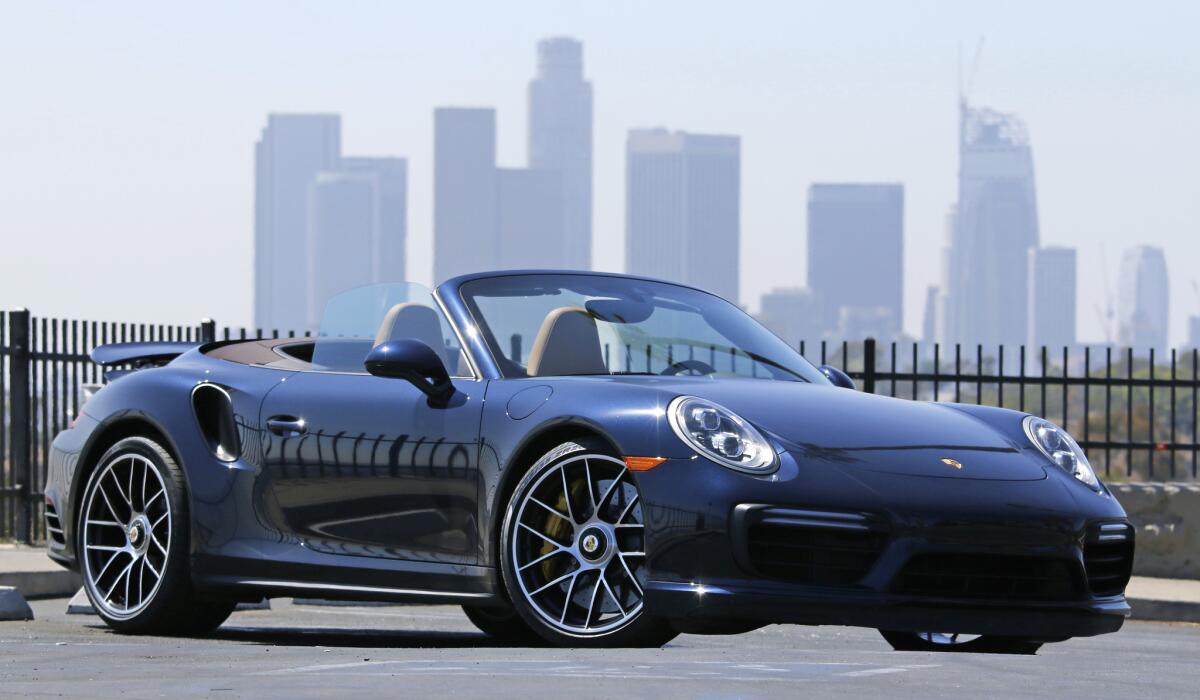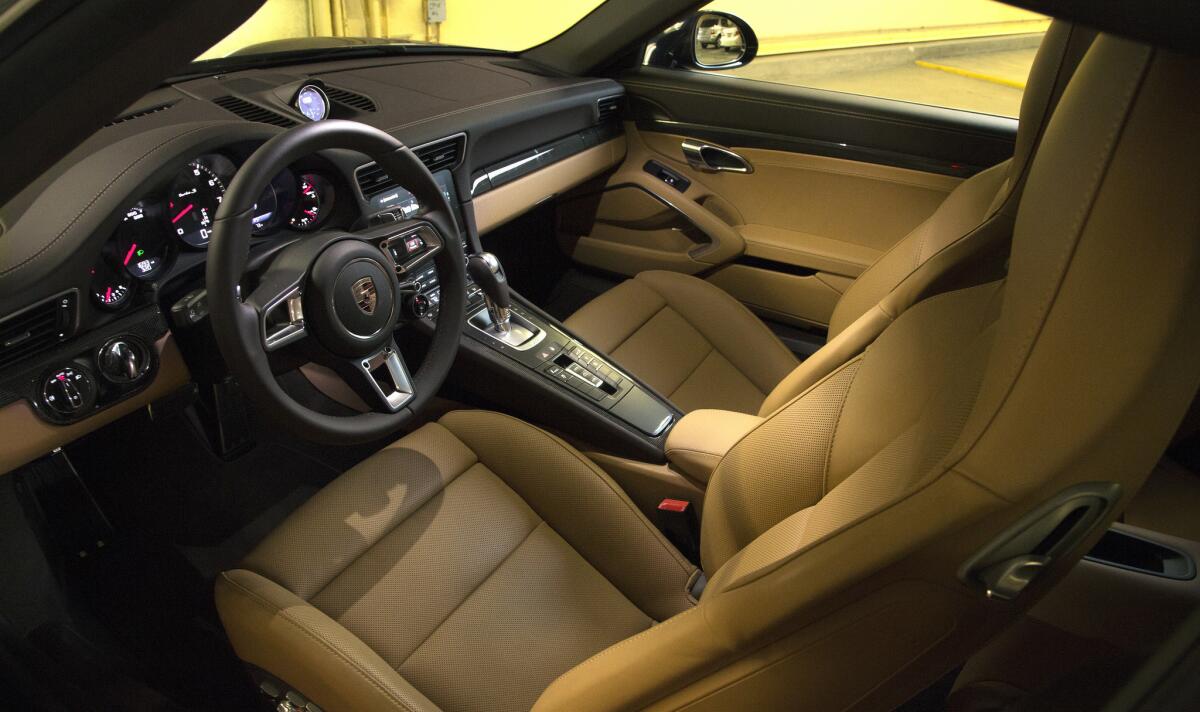Auto Review: With the 2017 911 Turbo S, Porsche has made the perfect car a little more perfect
Did the best just get better?
Porsche’s 2017 911 Turbo S is a faintly measurable fraction superior to the 2016 model. It’s so barely better that only a really first-rate driver would even notice.
I didn’t notice. To me, the 2017 version of this delicious sports car is virtually identical to its predecessor. Because that needed no improvement to impress me, I might not have been impressed by the upgrades.
They’re real, even if I can’t feel them. The 2017 911 Turbo S is equipped with bigger turbochargers, with larger impellers, plus modified cylinder heads and a throttle boost device designed to eliminate turbo lag.
Together, they help produce 20 more horsepower in the 2017 than was available in the identical 2016 version (580, up from 560), a 7-mphr increase in top track speed (205 mph, up from 198) and a 0.1 faster pace from zero to 60, (2.8 seconds, down from 2.9 — though the convertible version still takes that 2.9 seconds).
That makes this the quickest and fastest 911 ever built, and the quickest and fastest mass-production Porsche — after the limited-production 918 Spyder, which posted a 2.5-second sprint to 60 and a top track speed of 214 mph.
Somehow, along with the improved performance, the 2017 also offers improved fuel economy — about 2 miles per gallon better EPA mileage numbers — for a combined 21 mpg.
Like many of its Porsche siblings, the new 911 Turbo S is a rear-engine, all-wheel-drive roadster, designed as much for daily driving as for track-level performance.
It has a fair-sized trunk, big enough for two small overnight bags, and rear seats, but only big enough for two very small people or two medium-sized picnic baskets.
With the top up, the 911 Turbo S experiences a little wind noise and a little tire noise, at a level that might make intimate conversation above 4,000 rpms difficult.
But then the top slides down and Porsche’s raciest sports car becomes a cabriolet.

Sharp-eyed Porsche enthusiasts will note slight changes to the front and rear fascias. Others will just think it looks fantastic.
Migrating from other models are features that are new to the 911 Turbo S. From the Carrera 4 S comes the Dynamic Boost, which alters the fuel supply so the turbo chargers engage more instantaneously.
Also from the Carrera come a new navigation system and Apple CarPlay.
All 911 Turbos now come standard with Lane Change Assist and Park Assist programs, and a rear-view camera. They also include a lift system that raises the front end of the car by 1.5 inches — not a lot, but enough to keep you from dragging your chin on those low driveways.
The Turbo S, but not the non-S Turbo, comes standard with 18-way adjustable sport seats. It also includes the GT sports steering wheel, which places the driving mode options a thumb-length away — instead of on the center console. (You still have to reach that far for the Launch Control feature.)
A new Porsche Stability Management sport mode is also available for the first time. Porsche explains that this allows the driver to push the car closer to its limits before the vehicle’s stability control intervenes and straightens things out.
Apparently you have to push it pretty hard to make that happen. So, such a feature is wasted on me, as are the front spoiler and rear wing. These are said to generate 300 pounds of down force but that happens at such high speeds that they’d never occur with me behind the wheel.
Also new is the Sport Response Button, which when pressed releases maximum horsepower and torque for 20 seconds.

I’m not one of the old-fashioned drivers who believes that he can shift a manual transmission better than Porsche’s PDK automatic can.
There may not be many of those around anymore, and that’s part of why Porsche no longer offers this car with a stick shift. The paddle shifters do a better job, and the automatic transmission gets the car around the track faster anyway.
(If you insist on stick, Porsche still does offer that on the 718 Boxster, 718 Carrera, and 911 Carrera and Targa.)
My only quibble with the transmission is that the 911 insists on reverting to Normal mode every time the engine is shut off. If you prefer Sport mode, you have to choose that again on startup, every time. Porsche says this is a safety feature, so the driver does not forget the racier mode is engaged and go tearing off down the driveway first thing in the morning.
Porsche is having a fairly good 2016 in the U.S. Year-to-date sales through September were up 2.4% compared with the same period a year earlier.
That increase represents sales of 40,246 units overall. More than half of those were the family-friendly Cayennes and Macans, sales of which were up 30% over 2015.
But the next-best seller was the 911 line. And Porsche says one in four 911s sold in the U.S. are sold in California, to customers with an average annual income of $600,000.
So, we can hate them because they’re rich, or just envy them because they’re driving one of the finest cars on the road today. Or, we can just start saving.
2017 Porsche 911 Turbo S
Times’ take: Porsche’s priciest, most powerful sports car
Highs: So smooth, so fast, so much fun!
Lows: So expensive!
Vehicle type: Two-door, four-passenger convertible
Base price: $201,450
Price as tested: $209,000
Powertrain: 3.8-liter, twin-turbo, 6-cylinder engine
Transmission: 7-speed PDK automatic
Horsepower: 580
Torque: 553 pound-feet
EPA fuel economy rating: 19 mpg city / 24 mpg highway / 21 mpg combined




